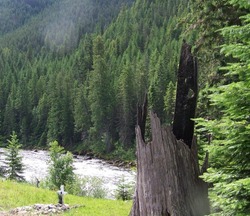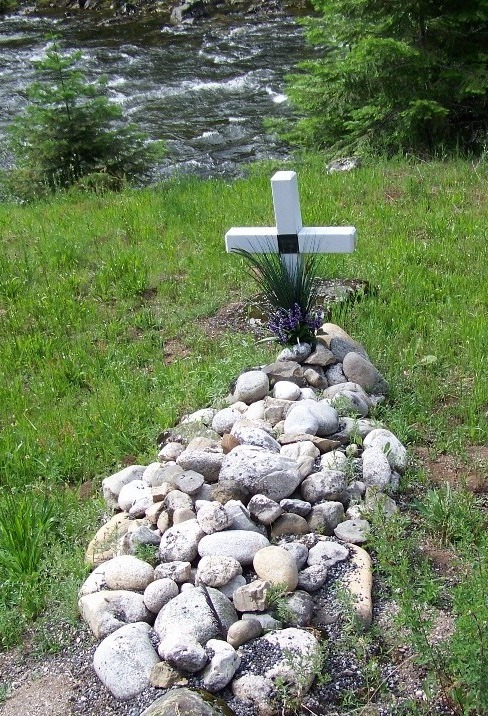It was not until 5 weeks had passed that friends became alarmed, A group of cavalrymen rode into Kendrick from Walla Walla and reported the hunting party was possibly snowed in and a search party had been sent out. Another search party from Fort Missoula had also been ordered out, but had to turn back because of the deep snow. General Carlin ordered out a third search party. The third party traveled fast and, without knowing it, passed the party from Kendrick. This party reached the junction of the Lochsa and Selway Rivers where they encountered two trappers. They enlisted the aid of the trappers, constructed two rafts, and poled upstream on the Lochsa. After two arduous days of fighting the current they came upon a camp containing all of the party except George Colgate. Carlin explained that Colgate had become sick and near death, so all the campers voted to leave him in the camp further up the river. The campers had constructed a clumsy raft that had come apart where they were found. It was never explained why none of the party went on up the river to search for Colgate.
Upon returning to Kendrick, Carlin stated they had tried to ride out on horses, but the snow was already belly deep, so they had to turn back to the river camp. That night their horses disappeared and were never seen again. The next morning the snow was falling more heavily and without snowshoes they decided to fight their way down the river. They made a mile the first day. They made another camp and stayed several days while they consumed almost all their food and supplies. Finally the storm had abated somewhat and the snow settled into somewhat of a crust. They decided to move downstream again, but complications had developed because Colgate had become too sick to travel. In a near panic, the others decided to leave him, constructed the raft and made it 30 miles downstream.
It was assumed that Colgate died immediately and it was written off as another wilderness travel and forgotten by most folks. Still there were a few who wondered about the incident and the following year in February, Charley Colgate, the cook's son, and a party went out to solve the riddle. With provisions for two weeks, they set out for the spot where George supposedly died. It took twice as long as expected, their clothes were in rags, and virtually all of their food was gone, but the search continued. One man was seriously wounded when a snag they set fire for warmth fell over on him. He had a broken collar bone, severe lacerations and burns on his body, but this time the rest of the party were determined to take care of the injured man..
After nursing him for almost a week, they fashioned a crude litter and carried him 30 miles to a trapper's cabin who had plenty of food. For several days they rested and started back to Kendrick. They were met by a search party looking for them. The injured man regained his health, but the trip had been in vain.
In the summer of 1894, Lieutenant Elliot, who had led the first rescue party was given a routine assignment to lead a survey party into the mountains where Colgate had been abandoned. By sheer accident they found a human skeleton with enough clothing remaining to identify it as Colgate. Nearby several articles were found that had been in his pockets. There was no question as to the identity. As the remains were found five or six miles further downstream from where he had been left, two schools of thought arose. One was that if he traveled that far alone, with help he could have been saved. The other was that the Carlin party did the right thing to leave him and ensure their own safety. The survey party took his remains on upriver to the hunting party's original campsite and buried him alongside the river.
About forty miles west of Lolo Pass, alongside Route 12 in central Idaho, a rest stop looks over Colgate's grave site.
However, all information contained here has been extracted from an article in the 1968 Summer edition of Old West Magazine and the original article was written by Roscoe Le Gresley.
===============================================
Birthplace: Washington Territory
Home in 1880: Dayton, Columbia, Washington
Race: White
Gender: Male
Relation to Head of House: Son
Marital Status: Single
Father's name: Geo. T. Colgate
Father's Birthplace: England
Mother's name: Fanny Colgate
Mother's Birthplace: England
Household Members:
Name Age
Geo. T. Colgate 38
Fanny Colgate 25
Charles Colgate 4
George Colgate 1
It was not until 5 weeks had passed that friends became alarmed, A group of cavalrymen rode into Kendrick from Walla Walla and reported the hunting party was possibly snowed in and a search party had been sent out. Another search party from Fort Missoula had also been ordered out, but had to turn back because of the deep snow. General Carlin ordered out a third search party. The third party traveled fast and, without knowing it, passed the party from Kendrick. This party reached the junction of the Lochsa and Selway Rivers where they encountered two trappers. They enlisted the aid of the trappers, constructed two rafts, and poled upstream on the Lochsa. After two arduous days of fighting the current they came upon a camp containing all of the party except George Colgate. Carlin explained that Colgate had become sick and near death, so all the campers voted to leave him in the camp further up the river. The campers had constructed a clumsy raft that had come apart where they were found. It was never explained why none of the party went on up the river to search for Colgate.
Upon returning to Kendrick, Carlin stated they had tried to ride out on horses, but the snow was already belly deep, so they had to turn back to the river camp. That night their horses disappeared and were never seen again. The next morning the snow was falling more heavily and without snowshoes they decided to fight their way down the river. They made a mile the first day. They made another camp and stayed several days while they consumed almost all their food and supplies. Finally the storm had abated somewhat and the snow settled into somewhat of a crust. They decided to move downstream again, but complications had developed because Colgate had become too sick to travel. In a near panic, the others decided to leave him, constructed the raft and made it 30 miles downstream.
It was assumed that Colgate died immediately and it was written off as another wilderness travel and forgotten by most folks. Still there were a few who wondered about the incident and the following year in February, Charley Colgate, the cook's son, and a party went out to solve the riddle. With provisions for two weeks, they set out for the spot where George supposedly died. It took twice as long as expected, their clothes were in rags, and virtually all of their food was gone, but the search continued. One man was seriously wounded when a snag they set fire for warmth fell over on him. He had a broken collar bone, severe lacerations and burns on his body, but this time the rest of the party were determined to take care of the injured man..
After nursing him for almost a week, they fashioned a crude litter and carried him 30 miles to a trapper's cabin who had plenty of food. For several days they rested and started back to Kendrick. They were met by a search party looking for them. The injured man regained his health, but the trip had been in vain.
In the summer of 1894, Lieutenant Elliot, who had led the first rescue party was given a routine assignment to lead a survey party into the mountains where Colgate had been abandoned. By sheer accident they found a human skeleton with enough clothing remaining to identify it as Colgate. Nearby several articles were found that had been in his pockets. There was no question as to the identity. As the remains were found five or six miles further downstream from where he had been left, two schools of thought arose. One was that if he traveled that far alone, with help he could have been saved. The other was that the Carlin party did the right thing to leave him and ensure their own safety. The survey party took his remains on upriver to the hunting party's original campsite and buried him alongside the river.
About forty miles west of Lolo Pass, alongside Route 12 in central Idaho, a rest stop looks over Colgate's grave site.
However, all information contained here has been extracted from an article in the 1968 Summer edition of Old West Magazine and the original article was written by Roscoe Le Gresley.
===============================================
Birthplace: Washington Territory
Home in 1880: Dayton, Columbia, Washington
Race: White
Gender: Male
Relation to Head of House: Son
Marital Status: Single
Father's name: Geo. T. Colgate
Father's Birthplace: England
Mother's name: Fanny Colgate
Mother's Birthplace: England
Household Members:
Name Age
Geo. T. Colgate 38
Fanny Colgate 25
Charles Colgate 4
George Colgate 1





